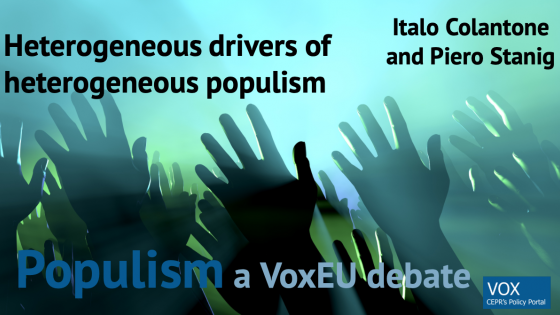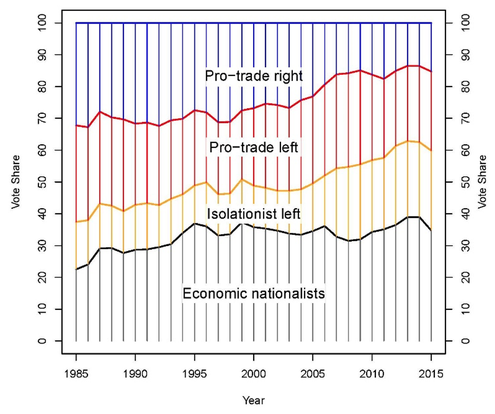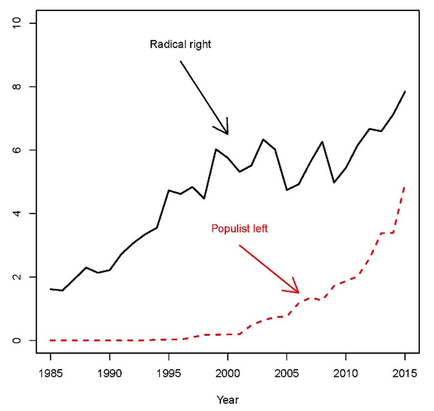This column is a lead commentary in the VoxEU debate on "Populism"
Populist parties and candidates share some identifying traits in terms of rhetoric and political narrative – they are against the establishment and claim to promote the interests of ordinary people versus the elites. However, they are very heterogeneous when it comes to policy proposals. For instance, their economic platforms range from very redistributive and interventionist on the extreme left of the political spectrum, to rather conservative on the extreme right.
In light of this consideration, we feel close to Mudde’s (2004) seminal definition of populism as a “thin-centered ideology”, based on the opposition between “pure people” and “corrupt elites”. In the limit, one could agree with Bonikowski (2016) when he argues that we should not even think about populism as an ideology, but rather as a discursive frame within which very different policy platforms can be conveyed. The question of whether or not populism should be considered an ideology, albeit a thin-centred one, is not very relevant for our own research purposes. What we take away from both approaches, and what our empirical analysis corroborates, is that populist parties are fundamentally heterogeneous.
A key finding that emerges consistently from our work, as reviewed in Colantone and Stanig (2019), is that not only are populist parties very heterogeneous, but also the drivers of their increasing support tend to be diverse. In particular, the distributional consequences of globalisation and automation have been significant determinants of support for radical-right parties – which are inherently populist – since the mid-1990s. Yet, the same factors do not explain at all the more recent success of the ‘left-wing populists’ in Western Europe. Thus, an important point that we make is that one should be extremely cautious in pooling together very heterogeneous parties when investigating empirically the drivers of populism.
A useful framework
As already pointed out by Guido Tabellini in a contribution to this Vox debate (Tabellini 2019), besides the classical left-right divide, a second dimension of political conflict has become increasingly salient over time: nationalism versus cosmopolitanism. In Colantone and Stanig (2019), we provide a useful framework for characterising parties based on both ideology dimensions. This is presented in Figure 1, where each data point corresponds to one party in one election across 15 western European countries, between 1985 and 2015. The variable on the horizontal axis is the degree of economic conservatism of the party, based on Manifesto Project data (Volkens et al. 2018). This score reflects the classical left-right divide on domestic economic issues. The variable on the vertical axis, nationalist autarchy, captures the ideological stance of the party in terms of nationalism, Euroscepticism, and isolationism. The dotted lines split the plot in four quadrants, based on the median positions on each policy dimension. We classify parties in the top-right quadrant as the economic nationalists. The top-left quadrant identifies the isolationist left. The bottom-left quadrant corresponds to the pro-trade and internationalist left, while the bottom-right area contains the pro-trade and internationalist right.
Where do the populists sit in this graph? The solid diamonds correspond to radical-right parties, identified based on the conventional wisdom in the political science literature. According to this literature, populism is indeed one of the main defining traits of the radical right, along with nativism and a critical stance towards liberal democracy (Golder 2016). Radical-right parties are mostly located in the top-right quadrant. That is, they tend to combine relatively conservative economic positions with rather isolationist, Eurosceptic and protectionist stances. Indeed, two decades ago, a seminal book identified this combination of policy proposals as the “winning formula” of the radical right (Kitschelt and McGann 1997). Yet a substantial number of economic nationalist parties are not classified as radical right but rather as Christian-democratic (triangles) or conservative (circles). Examples of these parties are National Alliance in Italy, National Coalition in Finland, Christian Union in the Netherlands, and the Dedecker List in Belgium. As it is plausible to expect, there is ideological heterogeneity within all party families. For instance, many parties commonly classified as radical right lie near the centre of the diagram, and some of them even sit slightly to the left of the median. Paradigmatic examples are provided by the True Finns in Finland, the Swiss Democrats in Switzerland, and the Sweden Democrats in Sweden, who are known for supporting a generous welfare state, even though they propose to restrict welfare access strictly to natives.
The solid squares identify six parties commonly referred to as ‘left-wing populists’ in the literature. These are Die Linke in Germany, Syriza in Greece, Sinn Fein in Ireland, the Five Star Movement in Italy, the Socialist Party in the Netherlands, and Podemos in Spain. They are indeed all located in the left-side of the chart, being in favour of redistribution and state intervention in the economy. Many of them lie in the isolationist-left camp (top-left quadrant), but some of them do not. Essentially, a closer look at the data reveals that these parties are all rather isolationist, Eurosceptic, and protectionist. However, the Nationalist Autarchy score, on the vertical axis, also includes nationalist stances in terms of support for traditional morality and way of life, where these parties tend to display low scores.
Figure 1 Policy bundles and parties in Western Europe
Note: Figure adapted from Colantone and Stanig (2019). Each data point is one party in one election between 1985 and 2015. Triangles refer to Christian-democratic parties; hollow squares are communist, socialist, and green parties; hollow dots are liberal and conservative parties; solid squares are populist left parties; solid diamonds are radical-right parties. The size of each symbol is proportional to (log) national vote share. The list of countries considered in the figure includes: Austria, Belgium, Finland, France, Germany, Greece, Ireland, Italy, Netherlands, Norway, Portugal, Spain, Sweden, Switzerland, and the UK. The group of radical-right parties includes: the FPÖ and the Team Frank Stronach in Austria; the Vlaams Blok and the Vlaams Belang in Belgium; the True Finns in Finland; the Front National in France; Golden Dawn and LAOS in Greece; the AFD, the NPD, and Die Republikaner in Germany; the Northern League in Italy; the PVV and the List Fortuyn in the Netherlands; the Sweden Democrats in Sweden; the AN/NA, the Swiss Democrats, the SVP, and the FPS in Switzerland; and the UKIP in the United Kingdom. The group of left-wing populist parties includes: Die Linke in Germany; Syriza in Greece; Sinn Fein in Ireland; the Five Star Movement in Italy; the Socialist Party in the Netherlands; Podemos in Spain.
Figure 2 reports the performance over time for the four groups of parties identified by the quadrants of Figure 1 (top panel), and for the families of radical-right and left-wing populist parties (bottom panel). Jointly considered, the two panels show a remarkable increase in support for economic nationalists in general, and for radical-right parties in particular. One can also see a substantial rise for the isolationist left more recently, especially since the years of the Great Recession and the euro crisis. Speaking to the growing salience of the nationalist versus cosmopolitan cleavage, it is important to note that the two isolationist/nationalist categories have risen from less than 40% of the total vote in 1985 to almost 60% in 2015. This is a remarkable and consequential change in the European political landscape.
Figure 2 Electoral dynamics by party group
Note: Figure adapted from Colantone and Stanig (2019). The top panel displays the cumulative vote share of economic nationalists (black line), plus isolationist left (yellow line), plus pro-trade left (red line), plus pro-trade right (blue line). The lines display 10-year moving averages of vote shares by ideological group in the 15 countries in our analysis. The bottom panel shows the evolution of support for the radical-right family (black solid line) and for left-wing populists (red dashed line). The lines display the 10-year moving averages of the vote shares for the two groups.
The economic drivers
As highlighted by other contributions to this debate, there is a growing body of evidence that economic factors play an important role in explaining increasing support for populist parties. In our own research, we have analysed specifically the political effects of two important dimensions of structural economic change: globalisation and automation. In particular, we have focused on the consequences of exposure to the Chinese import shock, and to the adoption of industrial robots, in 15 western European countries. These are all advanced industrialised economies with consolidated democracies.
The underlying idea behind our studies, consistent with Dani Rodrik’s contribution to this debate (Rodrik 2019), is that such phenomena generate distributional effects – both across regions and across individuals – that have, in turn, political implications. In Colantone and Stanig (2018a), we find that a stronger exposure to the China shock at the regional level causes an increase in support for economic nationalist and radical-right parties. We find analogous effects when considering exposure to robot adoption (in Anelli et al. 2019), both at the regional and at the individual level. At the same time, in both studies we never find any significant effect of the same shocks on support for protectionist left parties. Their success, in light of the national contexts and time period, seems to be rather due to austerity policies following the financial and sovereign debt crisis. This is what emerges, for instance, from our analysis of the Italian election of 2018.
Economy and culture
We strongly believe that the economy and culture should be seen as tightly interrelated rather than mutually exclusive explanations for the populist surge. For instance, one plausible channel through which economic shocks may play a role is by inducing changes in people’s attitudes and opinions. In our study of Brexit (Colantone and Stanig 2018b), we find that exposure to the China shock is a stronger predictor of negative attitudes concerning immigration than the actual presence of immigrants across regional areas. In Colantone and Stanig (2018c) we find that, in 15 European countries, exposure to Chinese competition leads not only to a surge in nativist attitudes, but also to lower support for democracy and liberal values. This nativist and authoritarian shift in public opinion naturally tilts voters towards the right and away from left parties, which are historically perceived as backing multiculturalism and international solidarity. This might provide an explanation for why recent structural economic changes do not seem to lead to higher support for pro-redistribution left-wing parties, as also noted by Tabellini in his contribution to this debate (Tabellini 2019).
In light of the documented link between economic factors and attitudes, we believe it is necessary to reiterate an important methodological point. In general, regressions of voting behaviour on economic conditions controlling for social attitudes are not suited to adjudicating a horse race between the two families of explanations. In fact, to the extent that attitudes are endogenous to economic determinants, they are essentially ‘bad controls’ in this type of analysis. This implies that the estimates obtained from such regressions are not informative of the respective roles of the economy and culture. For instance, one cannot interpret a lack of significance for the economic variables as compelling evidence that ‘the economy does not matter’.
Conclusion and future developments
Our findings on globalisation and automation suggest that the increasing support for nationalist and radical-right parties might not be simply an ephemeral ‘protest vote’. Instead, the contraposition of winners and losers from structural economic changes has created a new political cleavage that might last a long time. Along this new dividing line, the coalition of losers is mainly backing parties of the economic nationalist and radical-right type. The discontent behind such voting behaviour seems to be well grounded. Yet, it is ex ante unlikely that the recipes proposed by such parties can provide viable redress to individuals and communities in distress. In particular, a return to protectionism may have a disproportionate negative impact on low- and middle-income households. The relative economic conditions of the lower and middle classes would be further hampered by the only timidly redistributive – when not openly regressive – tax policies often proposed by these parties. It remains to be seen whether this will imply a setback of the nationalist and radical-right camp or rather its further radicalisation, and ultimately how the political arena will reach a new equilibrium after the current realignment.
Authors’ note: This column is based in part on our paper published in the Journal of Economic Perspectives (Colantone and Stanig 2019).
References
Anelli, M, I Colantone and P Stanig (2019), “We Were the Robots: Automation and Voting Behavior in Western Europe”, IZA Discussion Paper 12485.
Bonikowski, B (2016), “Three Lessons of Contemporary Populism in Europe and the United States.” Brown Journal of World Affairs 23(1): 9-25.
Colantone, I, and P Stanig (2018a), “The Trade Origins of Economic Nationalism: Import Competition and Voting Behavior in Western Europe”, American Journal of Political Science 62(4): 936-953.
Colantone, I, and P Stanig (2018b), “Global Competition and Brexit”, American Political Science Review 112(2): 201-218.
Colantone, I, and P Stanig (2018c), “The Economic Determinants of the ‘Cultural Backlash’: Globalization and Attitudes in Western Europe”, Baffi-Carefin Working Paper 2018-91.
Colantone, I, and P Stanig (2019), “The Surge of Economic Nationalism in Western Europe”, Journal of Economic Perspectives 33 (4): 128-151.
Golder, M (2016), “Far right parties in Europe”, Annual Review of Political Science 19: 477-497.
Kitschelt, H, and A J McGann (1997), The Radical Right in Western Europe: A Comparative Analysis, University of Michigan Press.
Mudde, C (2004), “The Populist Zeitgeist”, Government and Opposition 39(4): 541-563.
Rodrik, D (2019), “Many forms of populism”, VoxEU.org, 29 October.
Tabellini, G (2019), “The rise of populism”, 29 October.
Volkens, A, P Lehmann , T Matthieß, N Merz, S Regel and B Weßels, (2018), The Manifesto Data Collection. Manifesto Project (MRG/CMP/MARPOR), Version 2018a, Wissenschaftszentrum Berlin für Sozialforschung (WZB).






